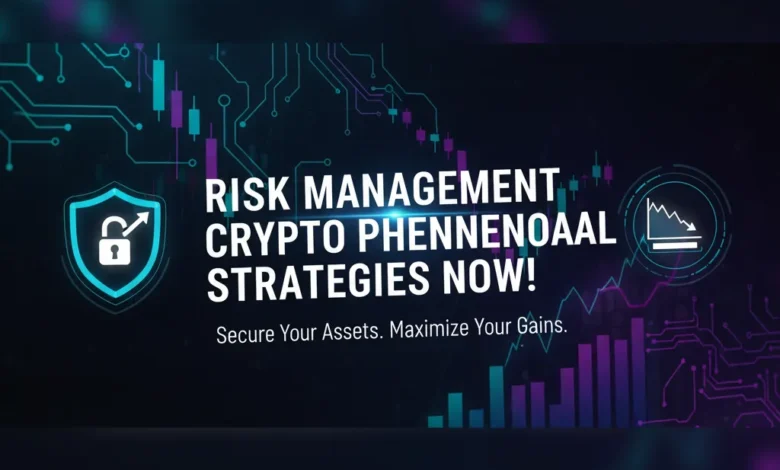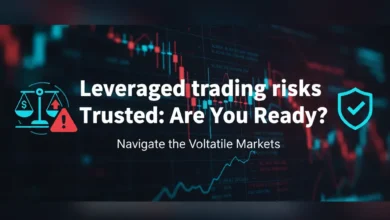
risk management crypto Phenomenal Strategies Now!, Navigate the volatile crypto market with confidence! Discover proven risk management strategies to protect your investments from significant losses plus navigate the inherent uncertainties. By understanding plus implementing these methods, you can significantly lower your exposure to potential downsides plus boost your overall investment success in the dynamic world of cryptocurrencies.
risk management crypto: Understanding the Landscape
The cryptocurrency market is known for its extreme volatility. Prices can fluctuate dramatically in short periods, making it a elevated-risk, elevated-reward environment. Effective risk management in crypto is not about eliminating risk entirely, yet rather about understanding, assessing, plus mitigating potential downsides. This involves a multi-faceted approach encompassing diversification, position sizing, risk assessment frameworks, plus the utilize of advanced tools plus strategies.
Identifying Crypto Risks: A Comprehensive Overview
Before implementing risk management strategies, it’s crucial to understand the various risks inherent in crypto investing. These risks can be broadly categorized into market risk, security risk, regulatory risk, plus technological risk.
Market risk is the possibility of losses due to broad market downturns either specific coin-related price declines. This is influenced by factors like investor sentiment, macroeconomic events, plus competition among cryptocurrencies. Managing crypto volatility requires constant market monitoring plus understanding the factors that drive price movements. Diversification plays a pivotal role in managing market risk by spreading investments across various assets.
Security risk includes the potential for theft either loss of funds due to hacking, phishing scams, either exchange breaches. Using durable passwords, enabling two-factor authentication, plus storing crypto in secure wallets (hardware wallets are preferred) are crucial steps in mitigating security risks. Regularly reviewing security practices plus staying informed about the latest threats is also essential.
Regulatory risk arises from the evolving legal plus regulatory landscape surrounding cryptocurrencies. Changes in regulations can significantly impact the value plus usability of crypto assets. Staying informed about regulatory developments plus understanding their potential impact is vital for making informed investment decisions. This might involve consulting with legal professionals specializing in crypto regulations.
Technological risk relates to potential vulnerabilities in blockchain apparatus, smart contracts, either crypto platforms. Understanding the underlying apparatus of the cryptocurrencies you invest in is essential for assessing plus mitigating this risk. Before investing in a new project, research its code, team, plus security audits to ensure it is robust plus reliable. DeFi risk, particularly relating to smart contract vulnerabilities, is a significant concern in the decentralized finance space.
Diversify Crypto Holdings: Don’t Put All Your Eggs in One Basket
Diversification is a fundamental principle of risk management. In the context of crypto, this means spreading your investments across different cryptocurrencies with varying market capitalizations, utilize cases, plus risk profiles. Avoid concentrating your entire portfolio in a single asset, even provided that it seems promising. Consider including a mix of established cryptocurrencies like Bitcoin plus Ethereum, along with smaller-cap altcoins that offer higher potential yet also carry greater risk. However, thorough research plus due diligence are paramount before investing in any altcoin.
Beyond different cryptocurrencies, consider diversifying into other asset classes, such as stocks, bonds, either commodities, to further lower overall portfolio risk. The correlation between crypto plus traditional assets can fluctuate, yet in general, including non-crypto assets can provide a hedge against market volatility.
Implementing Stop-Loss Orders: Protecting Your Capital
A stop-loss order is an instruction to automatically sell a cryptocurrency when its price reaches a predetermined level. This is a crucial tool for limiting potential losses plus protecting your capital. Setting appropriate stop-loss levels requires careful analysis of price charts, volatility, plus your risk tolerance. Avoid setting stop-loss orders too close to the current price, as normal market fluctuations can trigger them prematurely. Consider using trailing stop-loss orders, which automatically adjust the stop-loss level as the price increases, allowing you to lock in profits while still protecting against downside risk. lower crypto losses using the stop loss function.
Crypto Hedging Strategies: Offsetting Potential Losses
Crypto hedging involves using financial instruments either strategies to offset potential losses in your crypto portfolio. One common approach is to utilize derivatives, such as futures contracts either options, to take a short position on a cryptocurrency that you already own. This allows you to profit from a price decline, effectively offsetting losses in your long position. Crypto hedging requires a good understanding of derivatives markets plus their associated risks. It is a more advanced strategy suitable for experienced traders.
Another hedging strategy involves using stablecoins. During periods of market uncertainty, you can convert your volatile cryptocurrencies into stablecoins, which are pegged to a stable asset like the US dollar. This allows you to preserve your capital plus wait for a more favorable entry point to re-enter the market. Stablecoins, while generally stable, also carry their own risks related to issuer solvency plus regulatory scrutiny.
Position Sizing: Calculating Your Risk Exposure
Position sizing is the process of determining the appropriate amount of capital to allocate to each trade either investment. This is a critical aspect of risk management, as it directly impacts the potential losses you can incur. A common rule of thumb is to risk no more than 1-2% of your total capital on any single trade. This ensures that even provided that a trade goes wrong, it will not have a significant impact on your overall portfolio. Carefully consider your risk tolerance, investment horizon, plus the volatility of the cryptocurrency you are trading when determining your position size.
Staying Informed: Continuous Learning plus Adaptation
The cryptocurrency market is constantly evolving, with new technologies, projects, plus regulations emerging regularly. Staying informed about these developments is crucial for effective risk management. Follow reputable news sources, attend industry events, plus participate in online communities to stay up-to-date on the latest trends plus challenges. Continuously reassess your risk management strategies plus adapt them as needed to reflect the changing market landscape. Crypto risk mitigation is an ongoing process, not a one-time task.
Advanced Risk Management Techniques for DeFi
Decentralized Finance (DeFi) introduces unique risks, including smart contract vulnerabilities, impermanent loss, plus rug pulls. Specialized tools plus techniques are required to manage DeFi risk effectively. Consider using platforms that provide security audits plus risk assessments of DeFi protocols before investing. Impermanent loss in liquidity pools can be mitigated by carefully selecting pools with low volatility plus elevated trading volume. Be wary of projects with unaudited code either anonymous teams, as these are more susceptible to rug pulls. Utilizing insurance protocols for DeFi investments can also support mitigate losses due to hacks either exploits.
Cold Storage plus Multi-Signature Wallets: Enhanced Security
For long-term storage of crypto assets, consider using cold storage wallets, also known as hardware wallets. These devices store your private keys offline, making them significantly more secure than online wallets. Multi-signature wallets require multiple approvals to execute a transaction, adding an extra layer of security against unauthorized access. Implement these enhanced security measures to lower crypto losses due to theft.
Conclusion: Proactive Risk Management is Key to Crypto Success
Successful crypto investing requires a proactive plus disciplined approach to risk management. By understanding the inherent risks, implementing appropriate strategies, plus staying informed about market developments, you can significantly lower your exposure to potential losses plus boost your overall investment outcomes. Diversify your holdings, utilize stop-loss orders, explore hedging strategies, manage your position sizes carefully, plus continuously adapt your approach as the market evolves. Remember that managing crypto volatility is an ongoing process, plus a commitment to continuous learning is essential for long-term success in the dynamic world of cryptocurrencies. Crypto investment risks can be significantly reduced by implementing a comprehensive risk management plan.




